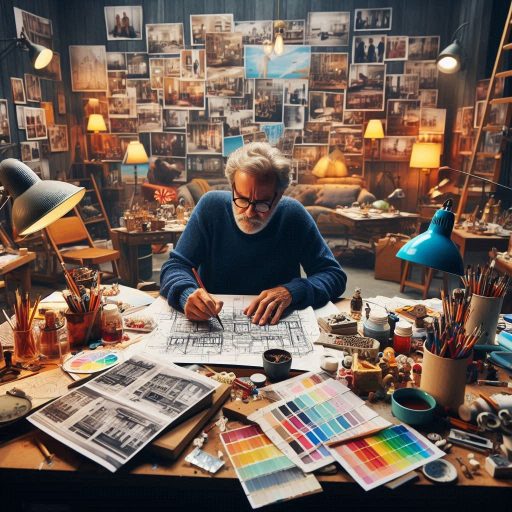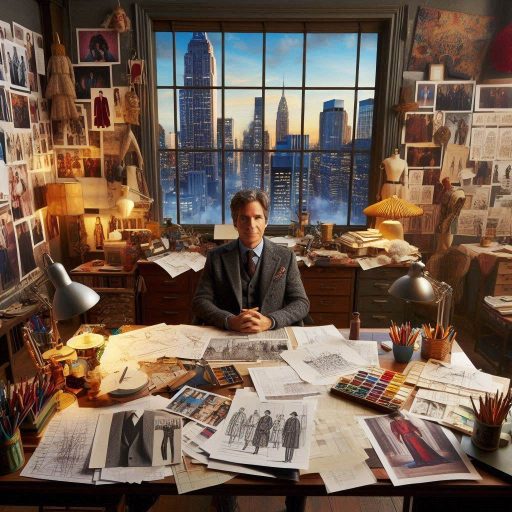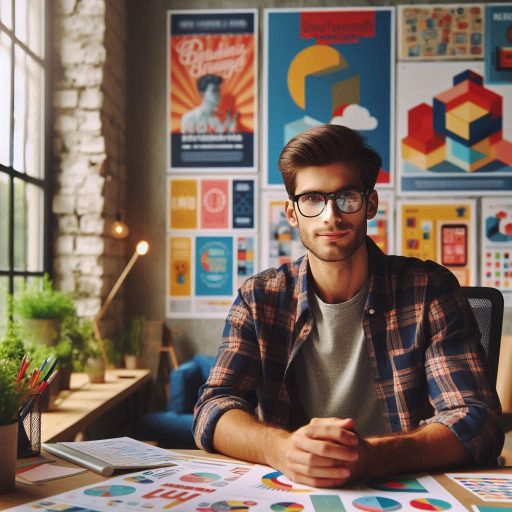Introduction
Modern production design focuses on creating visually engaging environments that enhance storytelling in film, television, theater, and events.
It blends traditional design principles with cutting-edge technology to craft immersive, memorable spaces.
Production designers are responsible for bringing these elements to life, ensuring that the visual experience supports the narrative.
In various industries, production design plays a crucial role in shaping the audience’s connection with the content.
In film and television, it establishes the setting, tone, and mood, making stories feel authentic and captivating.
Whether it’s a futuristic sci-fi world or a period drama, the design is vital in transporting viewers into the story’s universe.
In theater, production design enhances live performances by transforming stages into dynamic spaces that reflect the show’s themes.
For events and exhibitions, designers create unique, immersive experiences that leave lasting impressions on attendees.
Production design also influences branding and marketing efforts, as visually appealing spaces often lead to greater audience engagement.
As industries increasingly embrace digital media, designers are exploring virtual sets and augmented reality, pushing the boundaries of traditional design.
Modern production design is essential across industries.
Evolution of Production Design
The Historical Background of Production Design
Production design has been an essential part of filmmaking since the early 20th century.
Its roots trace back to silent films when early filmmakers realized the importance of visual storytelling.
Sets and environments played a key role in creating the atmosphere of silent films, where dialogue was absent.
As films evolved, so did the role of production designers.
The introduction of color and sound in the 1920s marked a turning point for design.
Filmmakers began to focus more on creating immersive worlds that enhanced the narrative.
Early production designers, like William Cameron Menzies, who worked on Gone with the Wind, set the stage for modern production design.
Menzies is often credited with defining the profession, being one of the first to receive the title of “production designer”.
The post-war era brought further advancements in technology, allowing production designers to experiment with new styles and techniques.
The advent of widescreen formats in the 1950s expanded the canvas for designers, enabling more detailed and expansive set designs.
During this period, production design became increasingly recognized as a vital artistic component in filmmaking.
In the 1970s and 1980s, the rise of blockbuster films and special effects expanded the possibilities of production design even further.
Designers worked hand-in-hand with special effects teams, creating futuristic worlds and epic landscapes.
Films like Star Wars and Blade Runner revolutionized production design, blending physical sets with groundbreaking visual effects.
Key Milestones in the Development of Modern Production Design
One of the key milestones in modern production design was the advent of computer-generated imagery (CGI).
In the 1990s, films like Jurassic Park and The Matrix demonstrated the potential of combining practical sets with digital enhancements.
Production designers embraced this technology, allowing them to create worlds that were previously impossible to build physically.
CGI expanded the designer’s toolbox, blending the physical and digital realms seamlessly.
Another major development in production design was the shift toward immersive, interactive environments.
In recent years, designers have increasingly focused on creating spaces that feel real and lived-in.
The use of practical effects, detailed set dressing, and thoughtful lighting contribute to these rich environments.
Films like Mad Max: Fury Road brought practical production design back into the spotlight, blending real-world locations with dynamic, stylized sets.
The growth of television as a prestige medium also shaped the evolution of modern production design.
In shows like Game of Thrones and The Crown, production design reached cinematic levels of complexity.
These shows demanded intricate, high-quality sets that could rival the designs seen in major films.
This development blurred the lines between television and film production design, raising the bar for both industries.
Sustainability has also become a growing trend in modern production design.
Designers are increasingly conscious of the environmental impact of their work.
Many have adopted eco-friendly practices, such as recycling sets or using sustainable materials.
This shift reflects broader industry efforts to reduce waste and promote green filmmaking.
The evolution of production design has been shaped by technological advancements, creative experimentation, and changing industry trends.
From the early days of silent films to the rise of CGI and immersive environments, production designers have continually adapted to new challenges and opportunities.
Read: Best Tools and Software for Character Designers
Technology in production design
How Technology Has Revolutionized Production Design
Technology has revolutionized modern production design, transforming how designers create and execute their vision.
Digital tools have streamlined many traditional processes, allowing for faster and more accurate designs.
Today, designers rely heavily on technology to enhance creativity, efficiency, and precision in their work.
Computer-aided design (CAD) software has become indispensable in production design.
Designers use CAD to create detailed blueprints, 3D models, and virtual environments.
These tools allow for better visualization and easier adjustments, saving time during the pre-production phase.
Technology also enables better communication within the production team.
Digital mood boards, shared files, and cloud-based platforms allow designers to collaborate seamlessly with directors, cinematographers, and other departments.
This level of coordination improves overall workflow, ensuring that everyone stays aligned with the creative vision.
Moreover, advancements in rendering technology have made it possible to generate realistic previews of designs before construction begins.
This capability allows production teams to spot potential issues early, reducing the need for costly revisions later in the process.
The Use of Tools Such as Software, 3D Printing, and Virtual Reality in Modern Production Design
Production designers now have access to cutting-edge tools that enhance creativity and problem-solving.
One key tool is design software, such as Autodesk Maya, SketchUp, and Adobe Creative Suite.
These programs enable designers to develop detailed sets, props, and environments with high precision.
3D printing has also gained popularity in modern production design.
Designers can create prototypes and custom pieces quickly and affordably.
3D printers allow production teams to experiment with shapes, textures, and materials that would be difficult or time-consuming to craft by hand.
This technology is particularly useful for creating intricate props or set pieces that require a high level of detail.
Virtual reality (VR) is another tool transforming production design.
With VR, designers can create fully immersive environments that directors and other collaborators can explore.
This technology allows for a more accurate visualization of how sets will appear on camera.
Designers can make real-time adjustments to lighting, scale, and textures, ensuring the final product meets creative expectations.
VR also enhances pre-visualization efforts.
Directors and production teams can virtually “walk through” sets before they are built, gaining a better understanding of how camera angles, movement, and lighting will interact with the space.
This level of immersion helps reduce the trial-and-error process during physical set construction.
Moreover, digital tools like augmented reality (AR) are finding their way into production design.
AR overlays virtual elements onto real-world environments, allowing designers to test concepts in existing spaces.
Incorporating technology has streamlined the production design process while opening new creative possibilities.
Designers can now push boundaries and experiment with innovative techniques, all while maintaining control over their creative vision.
By utilizing modern tools like software, 3D printing, and virtual reality, production designers enhance efficiency and deliver visually stunning results.
Read: Ceramic Art: From Hobby to Professional Career
Sustainable practices in production design
The Growing Trend of Sustainability in Production Design
Sustainability is becoming a major focus in modern production design.
Designers are increasingly mindful of their environmental impact.
As audiences and industries push for eco-conscious practices, production designers are embracing sustainable methods.
Many studios are committed to reducing waste and energy consumption.
This commitment influences the way sets are built and managed.
Production designers are now considering sustainability from the earliest stages of their projects.
A key trend involves reusing existing materials.
Instead of building new sets from scratch, designers repurpose older ones.
This reduces resource consumption while maintaining creative flexibility.
The use of recycled materials, such as wood and metal, also minimizes environmental harm.
Sustainable production design goes beyond materials.
Designers are exploring energy-efficient lighting and power solutions.
They are opting for LED lights, which consume less energy and last longer than traditional lighting.
Another important shift is the focus on sourcing locally.
By using materials and labor from nearby, designers reduce transportation emissions.
This not only benefits the environment but also supports local economies.
Production designers also promote sustainability by encouraging minimalism.
Instead of overproducing sets and props, they create multi-functional pieces.
These adaptable designs reduce the need for excessive construction and resource use.
How Designers Are Incorporating Eco-Friendly Materials and Practices Into Their Work
Eco-friendly materials are now central to sustainable production design.
Many designers are incorporating sustainable options without sacrificing visual quality.
Materials like bamboo, reclaimed wood, and non-toxic paints are frequently used to create stunning sets.
Bamboo, for example, is a highly sustainable material.
It grows quickly and requires minimal resources, making it an ideal choice for set construction.
Designers use bamboo for various purposes, from set walls to furniture.
Reclaimed wood is another popular eco-friendly option.
Designers salvage wood from demolished buildings or old sets and repurpose it for new projects.
This approach reduces the demand for new timber and keeps usable materials out of landfills.
Non-toxic paints and finishes are essential for creating healthier set environments.
Traditional paints often contain harmful chemicals that contribute to air pollution.
Eco-friendly alternatives, such as low-VOC or zero-VOC paints, protect both the environment and the crew’s health.
Sustainable practices also extend to costume and prop design.
Designers use organic and recycled fabrics for costumes, reducing reliance on synthetic materials.
Props made from biodegradable or upcycled materials ensure minimal waste generation during production.
Waste management plays a significant role in sustainable production design.
Designers are adopting recycling and composting programs on set.
These initiatives ensure that waste is processed responsibly rather than discarded in landfills.
Another innovative practice is digital set design.
By using advanced visual effects and virtual environments, designers can create complex worlds without physical materials.
This technology-driven approach significantly reduces waste and environmental strain.
Eco-friendly practices aren’t limited to big-budget productions.
Independent designers are also embracing sustainability.
They creatively adapt materials and techniques to fit eco-conscious principles while maintaining a high level of craftsmanship.
Read: How to Create Memorable Characters: Pro Tips

Collaboration in Production Design
The Importance of Collaboration in Modern Production Design
In modern production design, collaboration is essential for creating dynamic and innovative work.
Production design requires input from multiple departments, each contributing their unique expertise.
Collaboration ensures that all elements of a production align visually and thematically.
Effective collaboration begins with open communication between the director and the production designer.
The director shares their vision for the project, while the production designer translates that vision into tangible designs.
This collaborative process builds the foundation for the entire production’s aesthetic.
Working closely with the cinematographer is equally important.
The cinematographer and production designer collaborate on lighting, framing, and composition to ensure cohesive visual storytelling.
Production design directly impacts how a scene looks on camera, making their partnership vital.
Additionally, collaborating with costume designers helps maintain visual consistency.
Costumes and sets must complement each other to create a believable world.
Production designers work with costume designers to ensure that textures, colors, and styles align.
Collaborative efforts extend beyond creative teams to technical departments.
Production designers frequently work with construction teams to bring their ideas to life.
They ensure that practical set designs are feasible and meet budgetary constraints.
In today’s film and television industry, the need for teamwork and collaboration has never been more important.
A well-executed design results from the combined efforts of multiple professionals working toward a shared vision.
Multidisciplinary Teams Creating Innovative Designs
Modern production design thrives on the input of multidisciplinary teams.
These teams blend expertise from different creative and technical fields to produce cutting-edge designs.
Collaboration across disciplines allows for innovative solutions that push the boundaries of traditional design.
For instance, production designers often work with visual effects (VFX) artists to integrate digital elements into physical sets.
By blending practical designs with CGI, they create environments that would be impossible to build physically.
This multidisciplinary approach enhances the realism and depth of modern production design.
Set decorators and prop masters are also key members of the production design team.
Their role in selecting props and dressing sets brings life to a designer’s vision.
Collaborating with these experts ensures that every detail of a set adds to the overall narrative.
Designers must also work with sound designers to ensure visual elements support the audio landscape.
The texture, shape, and material of a set can influence how sound interacts with the space.
By collaborating closely, production designers and sound engineers create immersive environments.
Moreover, technology plays a pivotal role in production design today.
Designers must be proficient in design software and collaborate with tech experts to render detailed, accurate models.
Tools like 3D modeling and virtual reality allow designers to visualize complex sets before they are built.
The use of sustainable materials is another emerging trend that requires collaboration.
Designers work with environmental experts to create eco-friendly sets that reduce waste and energy consumption.
This collaboration not only benefits the environment but also leads to innovative design practices.
Collaboration is at the heart of modern production design.
Multidisciplinary teams bring together various skills and perspectives to create groundbreaking designs.
By working together, these professionals push the limits of creativity, producing visually stunning and immersive productions.
Read: Ceramic Art Exhibitions to Visit in 2024
Influences in Production Design
Exploring Influences on Modern Production Design
Modern production design draws inspiration from a variety of sources, including art, fashion, and technology.
These influences shape how designers approach their work and create visually captivating environments.
The blending of these elements allows production designers to craft unique worlds that resonate with contemporary audiences.
Art plays a significant role in production design, inspiring everything from color palettes to overall aesthetics.
Many designers reference specific art movements, such as surrealism or minimalism, to inform their choices.
These references help create mood and emotion in a scene, enhancing the storytelling.
Fashion, too, has a strong influence on production design.
Designers often look to current fashion trends to create costumes, set details, and visual themes.
Whether it’s through modern clothing styles or avant-garde couture, fashion shapes the visual language of productions.
It helps create characters that feel authentic to their worlds.
Technology has revolutionized production design in recent years.
With advancements in CGI, virtual reality, and digital rendering, designers now have more tools to bring their visions to life.
These technological innovations allow for more complex and immersive environments, blurring the lines between physical and digital spaces.
These varied influences enable production designers to keep their work fresh and relevant.
As trends in art, fashion, and technology evolve, so does the landscape of production design.
How Art, Fashion, and Technology Shape Design Trends
Art, fashion, and technology are more than just inspirations—they actively shape design trends in the industry.
Production designers incorporate artistic elements to make bold visual statements.
For example, the use of abstract art influences the creation of sets that are surreal and dreamlike.
This artistic direction can evoke emotion and engage the audience on a deeper level.
Minimalism, an ongoing trend in art and design, has also permeated production design.
Many designers now favor clean, simple lines and uncluttered spaces.
This aesthetic can emphasize storytelling by allowing the focus to remain on the characters and their actions.
Minimalist designs are particularly effective in futuristic or contemporary settings, offering a sleek, modern look.
Fashion trends, particularly in period dramas or fantasy genres, also drive production design.
Designers use current fashion as a starting point and then blend it with the needs of the story.
This approach helps create unique costumes and set pieces that feel both current and timeless.
For instance, bold colors, oversized silhouettes, and experimental fabrics often make their way from the runway to the screen.
Technology is arguably the most transformative influence on modern production design.
The ability to create detailed virtual sets and environments has expanded the possibilities for designers.
With digital tools, production designers can now design entire cities, landscapes, or worlds that feel fully immersive.
Virtual production techniques, such as LED screens and augmented reality, allow for real-time visualization, significantly enhancing creativity and flexibility on set.
Design trends are also moving towards sustainable practices, influenced by both fashion and technology.
Many production designers are exploring eco-friendly materials and digital solutions to reduce the environmental impact of large-scale sets.
This trend reflects a growing awareness of sustainability in the industry and influences how future projects are approached.
Customization and personalization in production design
Customization and Personalization: A Growing Trend in Modern Production Design
In recent years, customization and personalization have become central trends in modern production design.
Designers are increasingly focusing on creating tailored environments that reflect the unique needs and tastes of their clients.
This shift allows designers to offer something that feels exclusive and special, moving beyond mass-produced designs.
Clients today expect their environments to reflect their individuality.
This trend has pushed designers to craft one-of-a-kind spaces that feel deeply personal.
By understanding a client’s preferences, lifestyle, and aspirations, designers can create a design narrative that resonates with the client’s identity.
Customization goes beyond aesthetics.
Production designers now consider how functionality can be personalized.
Whether it’s a film set or a commercial space, the goal is to ensure the design not only looks good but serves a unique purpose.
Clients want spaces that cater to their specific needs, which makes this trend highly dynamic and flexible.
Creating Unique, One-of-a-Kind Designs
In response to the demand for personalization, production designers are moving towards creating unique, one-of-a-kind products.
This trend reflects a desire for exclusivity in design, where no two spaces or sets are exactly the same.
Clients often seek originality, and designers have embraced this by offering customized elements, from furniture to decor, that set their projects apart.
For example, instead of using standard props, designers may commission handcrafted items that align perfectly with a project’s theme.
This level of customization adds a layer of authenticity to the design, making the space feel truly unique.
Whether it’s an intricately designed chair or a bespoke lighting fixture, these personalized touches can elevate the overall aesthetic of the production.
This trend also applies to the materials used in production design.
Designers are experimenting with unconventional materials to create distinctive textures and finishes.
Clients increasingly want designs that cannot be replicated elsewhere, leading to a rise in innovative materials like reclaimed wood, handwoven fabrics, or sustainable composites.
Furthermore, technology plays a key role in this customization trend.
With advancements in 3D printing, designers can create custom objects and elements with precision.
This technology allows for rapid prototyping and highly detailed design elements that are tailored to each project.
3D printing also enables designers to experiment with new shapes, forms, and patterns that would be difficult to achieve through traditional methods.
The Impact of Customization on Client Relationships
Customization enhances the relationship between designers and clients.
The design process becomes a collaborative effort, where clients actively participate in the creation of their space.
This partnership fosters a stronger connection to the final product, as clients see their personal tastes and ideas reflected in the design.
The trend towards customization allows designers to offer a more immersive experience.
By involving clients in the decision-making process, designers can build trust and create designs that feel more personal.
This collaboration not only results in satisfied clients but also helps designers gain valuable insights into client expectations and preferences.
Incorporating these unique elements into production design ensures that the final result is memorable and impactful.
Whether it’s a home interior, commercial set, or film backdrop, personalized design creates a lasting impression that resonates with both clients and audiences.
The shift towards customization and personalization in production design is shaping the industry.
Clients increasingly expect unique, one-of-a-kind products that reflect their individuality and needs.
Designers are responding by creating bespoke environments and elements that offer a personalized experience.
As this trend continues to grow, it’s clear that customization will remain a defining aspect of modern production design.
Conclusion
Modern production design embraces key trends that are reshaping the industry.
One major trend is the use of sustainable materials.
Production designers increasingly focus on eco-friendly solutions to reduce waste and create greener sets.
Virtual production is another growing trend.
With tools like Unreal Engine, designers can create digital environments that seamlessly blend with live-action scenes.
This technology allows for more flexibility in design and reduces physical set costs.
Minimalist design has gained popularity in recent years.
Simple, clean lines and open spaces create visually striking settings that focus attention on characters and story.
Color psychology plays an important role in modern design.
Designers use specific color palettes to evoke emotions and convey themes, enhancing the audience’s experience.
Looking ahead, augmented reality (AR) and virtual reality (VR) are set to transform production design.
These technologies could allow designers to create fully immersive environments that interact with audiences in real time.
The future of production design will likely focus on further integration of digital tools and sustainable practices.
Designers will continue to push creative boundaries while embracing new technology.
As these trends evolve, production design will remain a powerful force in visual storytelling.
[E-Books for Sale]
The Big Book of 500 High-Paying Jobs in America: Unlock Your Earning Potential
$19.99 • 500 High-Paying Jobs • 330 pages
Explore 500 high-paying jobs in America and learn how to boost your career, earn more, and achieve success!
See All 500 High-Paying Jobs of this E-Book
1001 Professions Without a Degree: High-Paying American Jobs You Can Start Now
$19.99 • 1001 Professions Without a Degree • 174 pages
Discover 1001 high-paying jobs without a degree! Unlock career tips, skills, and success strategies for just $19.99!




